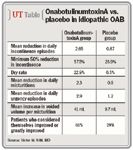Article
Botulinum toxin appears efficacious for idiopathic overactive bladder
Author(s):
Already approved for neurogenic overactive bladder, onabotulinumtoxinA (Botox) may now be on its way to garnering an indication for idiopathic OAB.
Atlanta-Already approved for neurogenic overactive bladder, onabotulinumtoxinA (Botox) may now be on its way to garnering an indication for idiopathic OAB. A phase III multicenter, randomized, placebo-controlled trial for this indication scored a success and was presented in a late-breaking session at the AUA annual meeting in Atlanta.
This trial compared 20 0.5-mL intradetrusor injections of onabotulinumtoxinA, sparing the trigone, to placebo administered in the same fashion in a total of 557 patients, all of whom were inadequately treated with anticholinergic drugs. Patients could not use anticholinergics during the trial. Assessment for effectiveness and safety was done at 12 weeks, with retreatment with 100 U of onabotulinumtoxinA permitted at or after that time in either group.
All the patients entering the trial had had OAB and incontinence for at least 6 months, at least three urinary urgency incontinence episodes in a 3-day diary, a frequency of at least eight per day, and a postvoid residual urine (PVR) of 100 mL or less. The two groups were similar in terms of age (about 61 years) and other characteristics and had severe conditions, averaging 5.1 to 5.5 incontinence episodes per day, reported coordinating investigator Victor W. Nitti, MD, vice chairman of urology at New York University Langone Medical Center, New York.

Micturitions followed this pattern, with active treatment reducing episodes (about 12 at baseline) by a mean of 2.3 per day, compared with 0.9 for placebo. Urgency episodes, averaging about eight per day at baseline, dropped by a mean of 2.9 per day in the treatment group compared with 1.2 per day in the placebo group. Voided volume per micturition went up by 41 mL in the treatment group compared with 9.7 mL in the placebo group.
The patients themselves reported significant improvements in their condition and quality of life. Sixty-one percent of the patients who received onabotulinumtoxinA judged that they were improved or greatly improved compared with only 29% of placebo patients. Results from the incontinence quality of life questionnaires were also "dramatic," said Dr. Nitti, who pointed out that a minimally important difference on the scale is 10 points on the Incontinence-Quality of Life questionnaire, but the active treatment patients "easily achieved and actually doubled this minimally important difference at all time points for the different domains, such as social embarrassment, as well as the total score, whereas placebo patients did not reach that minimally important difference in any of the domains," he emphasized.
Responses were also significantly greater for the treated group than the placebo group at week 12 on all domains evaluated on the King's Health Questionnaire quality of life assessment.
The adverse events that were the most common in this study and are of greatest concern with onabotulinumtoxinA injection were urinary tract infections and urinary retention requiring clean intermittent catheterization (defined as a PVR ≥200 mL and <350 mL with associated symptoms or a PVR ≥350 mL regardless of symptoms). Among the active treatment patients, 24.5% had UTIs at any time over the study's 24 weeks and 5.8% had retention.
"However, importantly, only 6.1% of patients initiated clean intermittent catheterization at any time during treatment cycle 1. This is a significantly lower percentage of patients than have been seen in other trials where higher doses of botulinum toxin were used," Dr. Nitti pointed out.
Dr. Nitti and co-investigators on this study have served as consultants for, conducted studies funded by, received honoraria from, and/or are employees of Allergan, Inc.
















